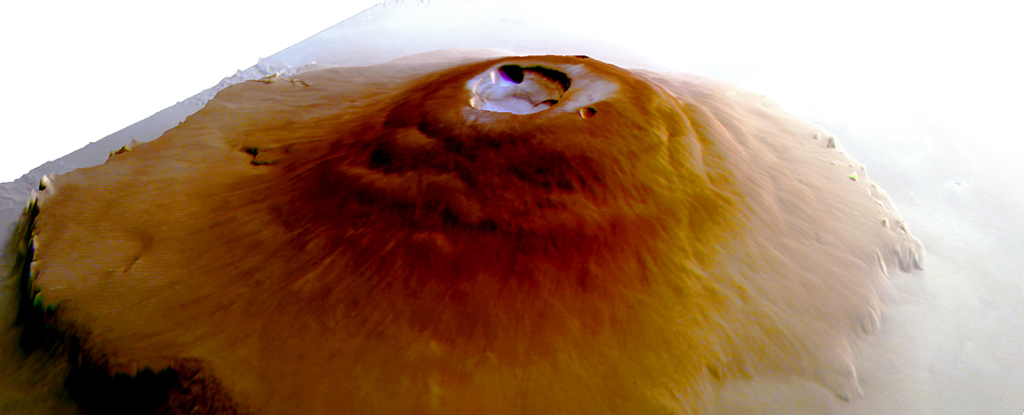It’s been known for years that there are large quantities of water ice locked up in the Martian poles. Around the equator however it is a barren dry wasteland devoid of any surface ice.
Recent observations of Mars have discovered frost on the giant shield volcanoes but it only appears briefly after sunrise and soon evaporates. Estimates suggest that 150,000 tons of water cycle between the surface and atmosphere on a daily basis.
The polar caps of Mars have been the subject of many studies in particular, since the discovery of water ice in 2008. They are permanent but vary in size with the seasons.
During the winter and in complete darkness, the surface chills allowing gas in the atmosphere to deposit on the surface as great bit chunks of carbon dioxide ice. Then the poles are exposed to sunlight again the frozen carbon dioxide sublimes straight back into a gas.
Aside from the carbon dioxide, the poles are mostly composed of frozen water ice. The carbon dioxide deposits are relatively thin compared to the water ice, only about 1 metre thick over the north pole. The south pole has a more permanent carbon dioxide cap about 8 metres thick.
A team of planetary scientists led by Adomas Valantinas, a postdoctoral fellow at Brown University who led the work as a PhD student at the University of Bern have detected water frost on top of the Tharsis volcanoes on Mars. These volcanoes are among the tallest on the planet and indeed one of them; Olympus Mons is the tallest in the Solar System.
The frost was discovered using high-resolution images from the Colour and Stereo Surface Imaging System (CaSSIS) which is just one of the instruments on the ESA Trace Gas Orbiter. The discovery was validated using further independent observations from the High Resolution Stereo Camera on Mars Express Orbiter.
This is the first time water frost has been discovered in the vicinity of the planet’s equator calling for a rethink of the planets climate dynamics. Until now, we thought it was quite unlikely for frost to form around the equator due to the levels of solar radiation and the thin atmosphere. The conditions mean the surface temperatures can reach reasonably high temperatures, too high for frosts to form even at the top of the volcanoes.
The study seems to show that frost is only fleeting present for a few hours after sunrise before the high temperatures cause it to evaporate in the solar radiation.
It is important to note that even though the frost is only a very thin later (just about the width of a human hair) it is thought that there is something like 150,000 tons of water that cycles between the surface and the atmosphere every day.
The frost the team have discovered deposits in the caldera of the volcanoes. These hollows are the openings at the summit of the volcano where eruptions have previously exploded out through the crust. It is now thought that there are unusual microclimates at the tops of the volcanoes which allows the thin layers of frost to form.
The discovery means we need to model how the frost forms to get a real understanding of where water might exist on Mars, how it moves and how it interacts with the atmosphere.
This article was originally published by Universe Today. Read the original article.











/https://tf-cmsv2-smithsonianmag-media.s3.amazonaws.com/filer_public/34/31/3431771d-41e2-4f97-aed2-c5f1df5295da/gettyimages-1441066266_web.jpg)








Discussion about this post